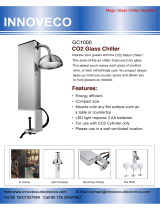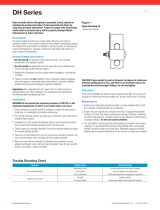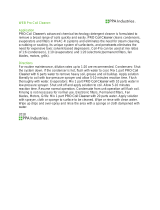
Application Handbook Industrial Refrigeration ammonia and CO
2
applications
© Danfoss A/S (AC-SMC/MWA), 2013-02 DKRCI.PA.000.C4.02 / 520H1623 1
Contents Page
Foreword.......................................................................................................... 3
1. Introduction .................................................................................................... 4
2. Compressor Controls ............................................................................................ 6
2.1 Compressor Capacity Control .............................................................................. 6
2.2 Discharge Temperature - Control with Liquid Injection . . . . . . . . . . . . . . . . . . . . . . . . . . . . . . . . . . . . . . . . . . . . . . . . . . . . . 10
2.3 Crankcase Pressure Control ...............................................................................13
2.4 Reverse Flow Control .....................................................................................14
2.5 Summary.................................................................................................15
2.6 Reference Documents ....................................................................................16
3. Condenser Controls ............................................................................................17
3.1 Air Cooled Condensers....................................................................................17
3.2 Evaporative Condensers ..................................................................................22
3.3 Water Cooled Condensers.................................................................................25
3.4 Summary.................................................................................................27
3.5 Reference Documents ....................................................................................27
4. Liquid Level Control ............................................................................................28
4.1 High Pressure Liquid Level Control System (HP LLRS).......................................................28
4.2 Low Pressure Liquid Level Control System (LP LLRS)........................................................32
4.3 Summary.................................................................................................36
4.4 Reference Documents ....................................................................................36
5. Evaporator Controls . . . . . . . . . . . . . . . . . . . . . . . . . . . . . . . . . . . . . . . . . . . . . . . . . . . . . . . . . . . . . . . . . . . . . . . . . . . . . . . . . . . . . . . . . . . . 37
5.1 Direct Expansion Control..................................................................................37
5.2 Pumped Liquid Circulation Control ........................................................................42
5.3 Hot Gas Defrost for DX Air Coolers.........................................................................45
5.4 Hot Gas Defrost for Pumped Liquid Circulation Air Coolers .................................................51
5.5 Multi Temperature Changeover ...........................................................................54
5.6 Media Temperature Control ...............................................................................55
5.7 Summary.................................................................................................57
5.8 Reference Documents ....................................................................................58
6. Oil Systems ....................................................................................................59
6.1 Oil cooling ...............................................................................................59
6.2 Oil Dierential Pressure Control ...........................................................................63
6.3 Oil Recovery System ......................................................................................66
6.4 Summary.................................................................................................68
6.5 Reference Documents ....................................................................................69
7. Safety systems .................................................................................................70
7.1 Pressure Relief Devices....................................................................................70
7.2 Pressure and Temperature Limiting Devices ...............................................................74
7.3 Liquid Level Devices ......................................................................................75
7.4 Refrigerant detector ......................................................................................76
7.5 Summary.................................................................................................78
7.6 Reference Documents ....................................................................................78
8. Refrigerant Pump Controls .....................................................................................79
8.1 Pump Protection with Dierential Pressure Control ........................................................79
8.2 Pump Bypass Flow Control................................................................................81
8.3 Pump Pressure Control....................................................................................82
8.4 Summary.................................................................................................83
8.5 Reference Documents ....................................................................................83
9. Others .........................................................................................................84
9.1 Filter Driers in Fluorinated Systems ........................................................................84
9.2 Water Removal for Ammonia Systems .....................................................................86
9.3 Air purging systems.......................................................................................90
9.4 Heat Recovery System ....................................................................................92
9.5 Reference Documents ....................................................................................94
10. Using CO
2
in refrigeration systems .............................................................................95
10.1 CO
2
as a refrigerant ......................................................................................96
10.2 CO
2
as a refrigerant in industrial systems..................................................................97
10.3 Design pressure .........................................................................................99
10.4 Safety ..................................................................................................101
10.5 Eciency ..............................................................................................102
10.6 Oil in CO
2
systems ......................................................................................102
10.7 Comparison of component requirements in CO
2
, ammonia and R134a systems ...........................104
10.8 Water in CO
2
Systems ...................................................................................106
10.9 Removing water........................................................................................109
10.10 How does water enter a CO
2
system? ...................................................................113
10.11 Miscellaneous features to be taken into consideration in CO
2
refrigeration systems ......................114
11. Pumped CO
2
in Industrial Refrigeration Systems...............................................................117
12. Control methods for CO
2
systems .............................................................................127
13. Design of a CO
2
sub-critical installation .......................................................................128
13.1 Electronic solution for liquid level control ...............................................................128
13.2 Hot Gas Defrost for Pumped Liquid Circulation Air Coolers ...............................................129
13.2 Hot Gas Defrost for Pumped Liquid Circulation Air Coolers ...............................................130
14. Filter Driers in CO
2
Systems . . . . . . . . . . . . . . . . . . . . . . . . . . . . . . . . . . . . . . . . . . . . . . . . . . . . . . . . . . . . . . . . . . . . . . . . . . . . . . . . . . . 131
15. Danfoss sub-critical CO
2
components.........................................................................132
16. Full range of stainless steel products .........................................................................134
17. Appendix ....................................................................................................136
Reference Documents - Alphabetical overview...................................................................149






















